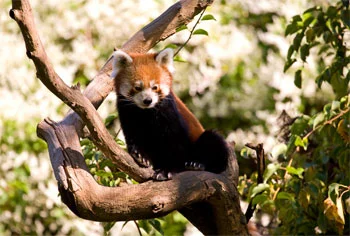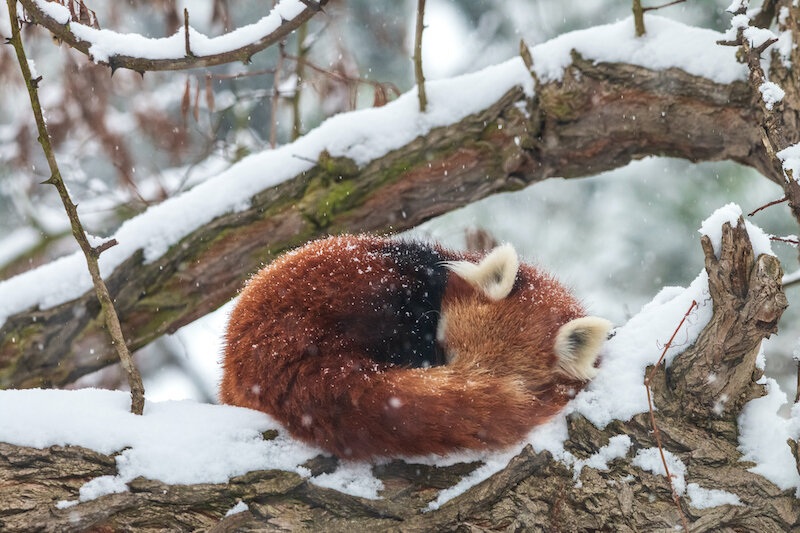A red panda is a bit bigger than a pet cat.
They have red fur and a long thick tail.
They eat mostly bamboo.
They spend most of their time in trees.
They live in mountain forests.
©Getty Images
What is a red panda?
The red panda is also called a Nepalese panda. It’s Chinese name is hun ho, meaning ‘fire fox’.
It is also called a 'lesser panda' because it is so much smaller than a giant panda, which was thought to be a relative. However, tests show that, although distantly related, it isn't just a small version of a giant panda, and scientists have classified it by itself in its own family.
Appearance
A red panda’s thick,striped tail is more than half its body length. ©Getty Images
Red pandas are 79 -120 cm long, including a 30 - 60 cm long tail, and they weigh 4-6 kg. The tail has six alternating reddish and yellowish stripes. The thick tail helps them balance in the trees, and they cover their faces with their tails in winter when they sleep.
The body fur is long and reddish in colour, dark on the under side. The colourings ensure excellent camouflage against the white lichen and red moss that cover the trees in which they live.
Faces are distinctly marked, with black nose and pointed ears.
Red pandas have thick fur on the soles of their feet, covering scent glands and providing warmth in the snow and ice.
Habitat and Distribution (where they are found)
They are found in high mountain bamboo forests in southern Asia, in parts of China (Sichuan and Yunnan), Bhutan, Nepal and the Himalayas, and Myanmar (Burma).
The thick furry tail helps keep a red panda warm when it sleeps in the cold. ©Getty Images
Behaviours
Red pandas are solitary, which means they live on their own, except for females with young. They move slowly when on the ground, but in the trees they are very agile. They are crepuscular (say creh-pus-kew-luh), which means they are active at dawn and dusk, resting for the rest of the day in tree branches and hollows.
They are fairly silent animals, except for some calls that sound like whistling or twittering. Red pandas wash themselves rather like cats, by licking their front paws and cleaning all their fur.
Diet
A red panda chewing on a bamboo stalk. ©Getty
Red pandas eat mostly bamboo, but they do also eat acorns, berries, blossoms, lichens and sometimes eggs.
They have a small bone that acts like a thumb, helping them grip the bamboo stalks as they eat.
Because bamboo does not provide a great deal of nutrition, red pandas spend a great deal of time sleeping in order to conserve energy.
Life Cycle
©Getty Images
About 130 days after mating with a male, a female red panda gives birth to between 1-4 cubs in summer.
Before they are born, the female makes a nest in a hollow tree or rock and lines it with plants.
The young stay in the nest for about 90 days, then stay with their mother until another litter of cubs is born in the following summer, when they leave.
They are fully grown at one year of age.
Red pandas live for about 8-10 years, but can live for 15.
Conservation Status and Threats
©Getty Images
Red pandas are classified as Endangered. They are protected in Nepal and China. The main reason for the decline in their numbers is loss of habitat. There are probably only about 2,500 adult red pandas left in the wild.
Main threats are from snow leopards, martens and humans.







